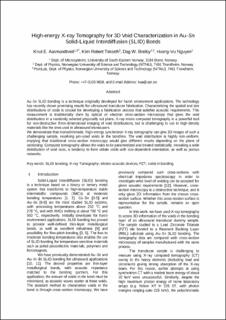High-energy X-ray Tomography for 3D Void Characterization in Au–Sn Solid-Liquid Interdiffusion (SLID) Bonds
Chapter, Peer reviewed
Accepted version
Permanent lenke
https://hdl.handle.net/11250/2650139Utgivelsesdato
2019Metadata
Vis full innførselSamlinger
- Institutt for fysikk [2686]
- Publikasjoner fra CRIStin - NTNU [38015]
Originalversjon
European Microelectronics and Packaging Conference & Exhibition (EMPC). 2019, 22 10.23919/EMPC44848.2019.8951843Sammendrag
Au-Sn SLID bonding is a technique originally developed for harsh environment applications. The technology has recently shown promising results for ultrasound transducer fabrication. Characterizing the spatial and size distributions of voids is crucial for developing a fabrication process that satisfies acoustic requirements. This measurement is traditionally done by optical or electron cross-section microscopy that gives the void distribution in a randomly selected physically cut plane. X-ray micro computed tomography is a powerful tool for non-destructive three-dimensional imaging of void distributions, but is challenging to use in high-density materials like the ones used in ultrasound transducers. We demonstrate that monochromatic, high-energy synchrotron X-ray tomography can give 3D images of such a challenging sample, resolving μm-sized voids in the bondline. The void distribution is highly non-uniform, implying that traditional cross-section microscopy would give different results depending on the plane of sectioning. Computed tomography allows the voids to be parametrized and treated statistically, revealing a wide distribution of void sizes, a tendency to form oblate voids with size-dependent orientation, as well as porous networks.
